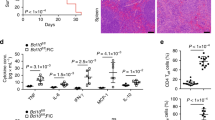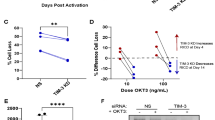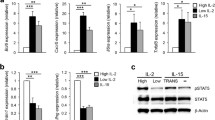Abstract
BTLA (B- and T-lymphocyte attenuator) is a prominent co-receptor that is structurally and functionally related to CTLA-4 and PD-1. In T cells, BTLA inhibits TCR-mediated activation. In B cells, roles and functions of BTLA are still poorly understood and have never been studied in the context of B cells activated by CpG via TLR9. In this study, we evaluated the expression of BTLA depending on activation and differentiation of human B cell subsets in peripheral blood and lymph nodes. Stimulation with CpG upregulated BTLA, but not its ligand: herpes virus entry mediator (HVEM), on B cells in vitro and sustained its expression in vivo in melanoma patients after vaccination. Upon ligation with HVEM, BTLA inhibited CpG-mediated B cell functions (proliferation, cytokine production, and upregulation of co-stimulatory molecules), which was reversed by blocking BTLA/HVEM interactions. Interestingly, chemokine secretion (IL-8 and MIP1β) was not affected by BTLA/HVEM ligation, suggesting that BTLA-mediated inhibition is selective for some but not all B cell functions. We conclude that BTLA is an important immune checkpoint for B cells, as similarly known for T cells.






Similar content being viewed by others
Abbreviations
- BTLA:
-
B- and T-lymphocyte attenuator
- CFSE:
-
Carboxyfluoresceine diacetate succinimidyl ester
- HVEM:
-
Herpes virus entry mediator
- PBMC:
-
Peripheral blood mononuclear cells
- s.c.:
-
Subcutaneous
- TLR:
-
Toll-like receptor
References
Peggs KS, Quezada SA, Allison JP (2008) Cell intrinsic mechanisms of T-cell inhibition and application to cancer therapy. Immunol Rev 224:141–165
Watanabe N, Gavrieli M, Sedy JR, Yang J, Fallarino F, Loftin SK, Hurchla MA, Zimmerman N, Sim J, Zang X et al (2003) BTLA is a lymphocyte inhibitory receptor with similarities to CTLA-4 and PD-1. Nat Immunol 4:670–679
Han P, Goularte OD, Rufner K, Wilkinson B, Kaye J (2004) An inhibitory Ig superfamily protein expressed by lymphocytes and APCs is also an early marker of thymocyte positive selection. J Immunol 172:5931–5939
Hurchla MA, Sedy JR, Gavrieli M, Drake CG, Murphy TL, Murphy KM (2005) B and T lymphocyte attenuator exhibits structural and expression polymorphisms and is highly induced in anergic CD4+ T cells. J Immunol 174:3377–3385
Gavrieli M, Watanabe N, Loftin SK, Murphy TL, Murphy KM (2003) Characterization of phosphotyrosine binding motifs in the cytoplasmic domain of B and T lymphocyte attenuator required for association with protein tyrosine phosphatases SHP-1 and SHP-2. Biochem Biophys Res Commun 312:1236–1243
Sedy JR, Gavrieli M, Potter KG, Hurchla MA, Lindsley RC, Hildner K, Scheu S, Pfeffer K, Ware CF, Murphy TL et al (2005) B and T lymphocyte attenuator regulates T cell activation through interaction with herpesvirus entry mediator. Nat Immunol 6:90–98
Derre L, Rivals JP, Jandus C, Pastor S, Rimoldi D, Romero P, Michielin O, Olive D, Speiser DE (2010) BTLA mediates inhibition of human tumor-specific CD8+ T cells that can be partially reversed by vaccination. J Clin Invest 120:157–167
Krieg C, Han P, Stone R, Goularte OD, Kaye J (2005) Functional analysis of B and T lymphocyte attenuator engagement on CD4+ and CD8+ T cells. J Immunol 175:6420–6427
Otsuki N, Kamimura Y, Hashiguchi M, Azuma M (2006) Expression and function of the B and T lymphocyte attenuator (BTLA/CD272) on human T cells. Biochem Biophys Res Commun 344:1121–1127
Vendel AC, Calemine-Fenaux J, Izrael-Tomasevic A, Chauhan V, Arnott D, Eaton DL (2009) B and T lymphocyte attenuator regulates B cell receptor signaling by targeting Syk and BLNK. J Immunol 182:1509–1517
Peng SL (2005) Signaling in B cells via Toll-like receptors. Curr Opin Immunol 17:230–236
Iwasaki A, Medzhitov R (2004) Toll-like receptor control of the adaptive immune responses. Nat Immunol 5:987–995
Takeda K, Akira S (2005) Toll-like receptors in innate immunity. Int Immunol 17:1–14
Bourke E, Bosisio D, Golay J, Polentarutti N, Mantovani A (2003) The toll-like receptor repertoire of human B lymphocytes: inducible and selective expression of TLR9 and TLR10 in normal and transformed cells. Blood 102:956–963
Busconi L, Bauer JW, Tumang JR, Laws A, Perkins-Mesires K, Tabor AS, Lau C, Corley RB, Rothstein TL, Lund FE et al (2007) Functional outcome of B cell activation by chromatin immune complex engagement of the B cell receptor and TLR9. J Immunol 179:7397–7405
Hemmi H, Takeuchi O, Kawai T, Kaisho T, Sato S, Sanjo H, Matsumoto M, Hoshino K, Wagner H, Takeda K et al (2000) A Toll-like receptor recognizes bacterial DNA. Nature 408:740–745
Leadbetter EA, Rifkin IR, Hohlbaum AM, Beaudette BC, Shlomchik MJ, Marshak-Rothstein A (2002) Chromatin-IgG complexes activate B cells by dual engagement of IgM and Toll-like receptors. Nature 416:603–607
Viglianti GA, Lau CM, Hanley TM, Miko BA, Shlomchik MJ, Marshak-Rothstein A (2003) Activation of autoreactive B cells by CpG dsDNA. Immunity 19:837–847
Lienard D, Rimoldi D, Marchand M, Dietrich PY, van Baren N, Geldhof C, Batard P, Guillaume P, Ayyoub M, Pittet MJ et al (2004) Ex vivo detectable activation of Melan-A-specific T cells correlating with inflammatory skin reactions in melanoma patients vaccinated with peptides in IFA. Cancer Immun 4:4
Speiser DE, Lienard D, Rufer N, Rubio-Godoy V, Rimoldi D, Lejeune F, Krieg AM, Cerottini JC, Romero P (2005) Rapid and strong human CD8+ T cell responses to vaccination with peptide, IFA, and CpG oligodeoxynucleotide 7909. J Clin Invest 115:739–746
Abbas AR, Baldwin D, Ma Y, Ouyang W, Gurney A, Martin F, Fong S, van Lookeren CM, Godowski P, Williams PM et al (2005) Immune response in silico (IRIS): immune-specific genes identified from a compendium of microarray expression data. Genes Immun 6:319–331
Suryani S, Fulcher DA, Santner-Nanan B, Nanan R, Wong M, Shaw PJ, Gibson J, Williams A, Tangye SG (2010) Differential expression of CD21 identifies developmentally and functionally distinct subsets of human transitional B cells. Blood 115:519–529
Serriari NE, Gondois-Rey F, Guillaume Y, Remmerswaal EB, Pastor S, Messal N, Truneh A, Hirsch I, van Lier RA, Olive D (2010) B and T lymphocyte attenuator is highly expressed on CMV-specific T cells during infection and regulates their function. J Immunol 185:3140–3148
Krieg AM (2002) CpG motifs in bacterial DNA and their immune effects. Annu Rev Immunol 20:709–760
Klein U, Rajewsky K, Kuppers R (1998) Human immunoglobulin (Ig)M + IgD + peripheral blood B cells expressing the CD27 cell surface antigen carry somatically mutated variable region genes: CD27 as a general marker for somatically mutated (memory) B cells. J Exp Med 188:1679–1689
Palanichamy A, Barnard J, Zheng B, Owen T, Quach T, Wei C, Looney RJ, Sanz I, Anolik JH (2009) Novel human transitional B cell populations revealed by B cell depletion therapy. J Immunol 182:5982–5993
M’Hidi H, Thibult ML, Chetaille B, Rey F, Bouadallah R, Nicollas R, Olive D, Xerri L (2009) High expression of the inhibitory receptor BTLA in T-follicular helper cells and in B-cell small lymphocytic lymphoma/chronic lymphocytic leukemia. Am J Clin Pathol 132:589–596
Harwood NE, Batista FD (2011) The cytoskeleton coordinates the early events of B-cell activation. Cold Spring Harb, Perspect Biol 3(2)
Greenwald RJ, Freeman GJ, Sharpe AH (2005) The B7 family revisited. Annu Rev Immunol 23:515–548
Loder F, Mutschler B, Ray RJ, Paige CJ, Sideras P, Torres R, Lamers MC, Carsetti R (1999) B cell development in the spleen takes place in discrete steps and is determined by the quality of B cell receptor-derived signals. J Exp Med 190:75–89
Carsetti R, Rosado MM, Wardmann H (2004) Peripheral development of B cells in mouse and man. Immunol Rev 197:179–191
Weller S, Faili A, Garcia C, Braun MC, Le Deist FF, de Saint Basile GG, Hermine O, Fischer A, Reynaud CA, Weill JC (2001) CD40-CD40L independent Ig gene hypermutation suggests a second B cell diversification pathway in humans. Proc Natl Acad Sci U S A 98:1166–1170
Kruetzmann S, Rosado MM, Weber H, Germing U, Tournilhac O, Peter HH, Berner R, Peters A, Boehm T, Plebani A et al (2003) Human immunoglobulin M memory B cells controlling Streptococcus pneumoniae infections are generated in the spleen. J Exp Med 197:939–945
Murphy TL, Murphy KM (2010) Slow down and survive: enigmatic immunoregulation by BTLA and HVEM. Annu Rev Immunol 28:389–411
Oya Y, Watanabe N, Owada T, Oki M, Hirose K, Suto A, Kagami S, Nakajima H, Kishimoto T, Iwamoto I et al (2008) Development of autoimmune hepatitis-like disease and production of autoantibodies to nuclear antigens in mice lacking B and T lymphocyte attenuator. Arthritis Rheum 58:2498–2510
Lin YC, Huang DY, Chu CL, Lin WW (2010) Anti-inflammatory actions of Syk inhibitors in macrophages involve non-specific inhibition of Toll-like receptors-mediated JNK signaling pathway. Mol Immunol 47:1569–1578
Sanjuan MA, Rao N, Lai KT, Gu Y, Sun S, Fuchs A, Fung-Leung WP, Colonna M, Karlsson L (2006) CpG-induced tyrosine phosphorylation occurs via a TLR9-independent mechanism and is required for cytokine secretion. J Cell Biol 172:1057–1068
Rauch PJ, Chudnovskiy A, Robbins CS, Weber GF, Etzrodt M, Hilgendorf I, Tiglao E, Figueiredo JL, Iwamoto Y, Theurl I et al. (2012) Innate response activator B cells protect against microbial sepsis. Science 335:597-601
Cai G, Anumanthan A, Brown JA, Greenfield EA, Zhu B, Freeman GJ (2008) CD160 inhibits activation of human CD4+ T cells through interaction with herpesvirus entry mediator. Nat Immunol 9:176–185
Anumanthan A, Bensussan A, Boumsell L, Christ AD, Blumberg RS, Voss SD, Patel AT, Robertson MJ, Nadler LM, Freeman GJ (1998) Cloning of BY55, a novel Ig superfamily member expressed on NK cells, CTL, and intestinal intraepithelial lymphocytes. J Immunol 161:2780–2790
Maiza H, Leca G, Mansur IG, Schiavon V, Boumsell L, Bensussan A (1993) A novel 80-kD cell surface structure identifies human circulating lymphocytes with natural killer activity. J Exp Med 178:1121–1126
Mauri DN, Ebner R, Montgomery RI, Kochel KD, Cheung TC, Yu GL, Ruben S, Murphy M, Eisenberg RJ, Cohen GH et al (1998) LIGHT, a new member of the TNF superfamily, and lymphotoxin alpha are ligands for herpesvirus entry mediator. Immunity 8:21–30
Weiner GJ (2009) CpG oligodeoxynucleotide-based therapy of lymphoid malignancies. Adv Drug Deliv Rev 61:263–267
Vollmer J, Krieg AM (2009) Immunotherapeutic applications of CpG oligodeoxynucleotide TLR9 agonists. Adv Drug Deliv Rev 61:195–204
Cheung TC, Steinberg MW, Oborne LM, Macauley MG, Fukuyama S, Sanjo H, D’Souza C, Norris PS, Pfeffer K, Murphy KM et al (2009) Unconventional ligand activation of herpesvirus entry mediator signals cell survival. Proc Natl Acad Sci U S A 106:6244–6249
Acknowledgments
We are obliged to the patients and healthy volunteers for their dedicated collaboration. We thank Dr. Daniel Isnardon and Sébastien Létard for discussion and technical insights. We thank Pfizer and Coley Pharmaceutical Group for pharmaceutical products. This work was supported by grants from Institut National de la Santé et de la Recherche Médicale, the Ludwig Institute for Cancer Research, and the Swiss Cancer League. ML Thibult has been supported by fellowships from Ministère de la Recherche et de l’Enseignement Supérieur and from La Ligue contre le Cancer.
Disclosure of conflict of interest
The authors declare no competing financial interests.
Author information
Authors and Affiliations
Corresponding author
Additional information
Marie-Laure Thibult, Jean-Paul Rivals, Daniel Olive, and Laurent Derré contributed equally to this work.
Electronic supplementary material
Below is the link to the electronic supplementary material.
ESM 1
(PDF 618 kb)
Rights and permissions
About this article
Cite this article
Thibult, ML., Rivals, JP., Mamessier, E. et al. CpG-ODN-induced sustained expression of BTLA mediating selective inhibition of human B cells. J Mol Med 91, 195–205 (2013). https://doi.org/10.1007/s00109-012-0943-7
Received:
Revised:
Accepted:
Published:
Issue Date:
DOI: https://doi.org/10.1007/s00109-012-0943-7




